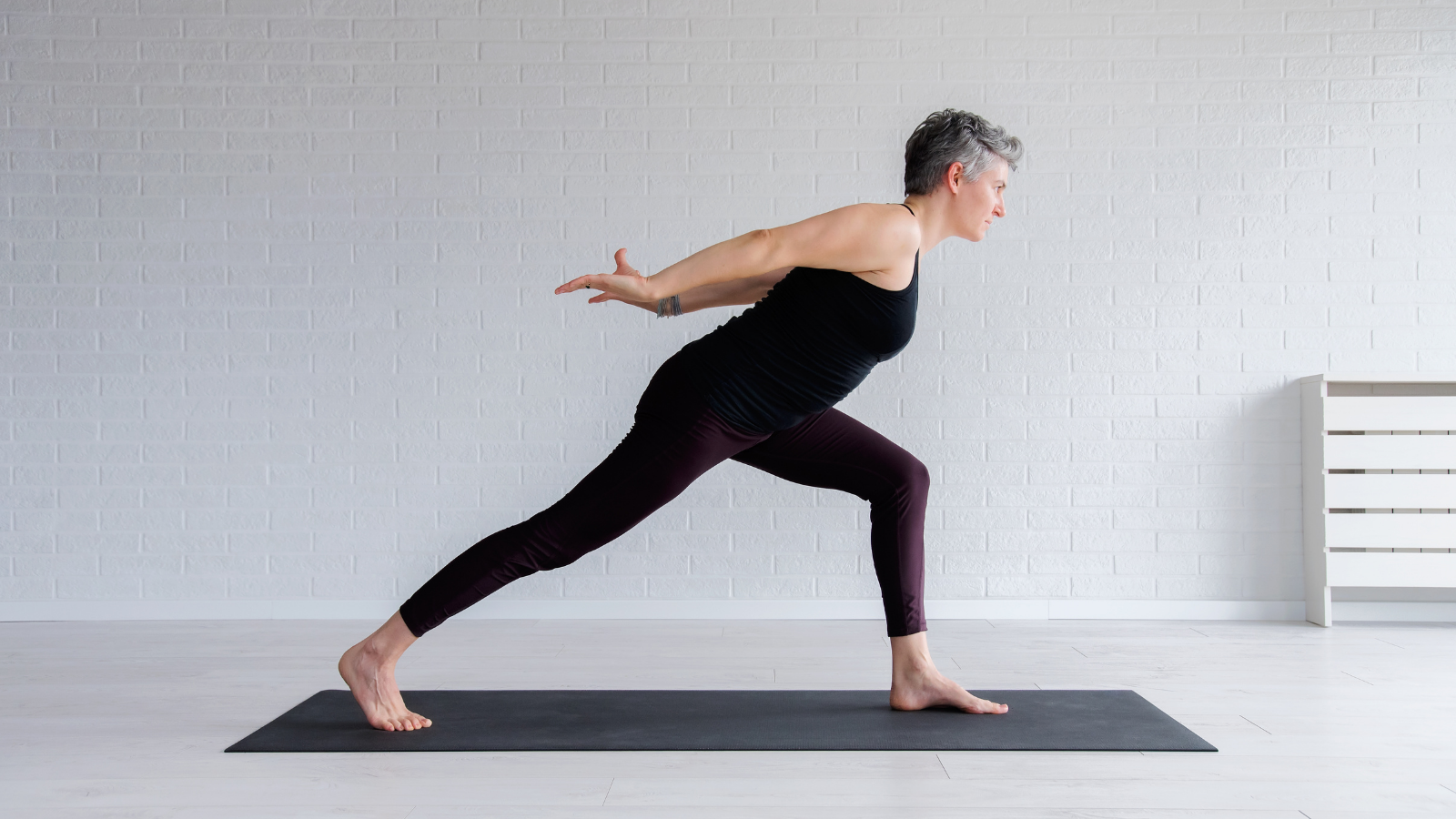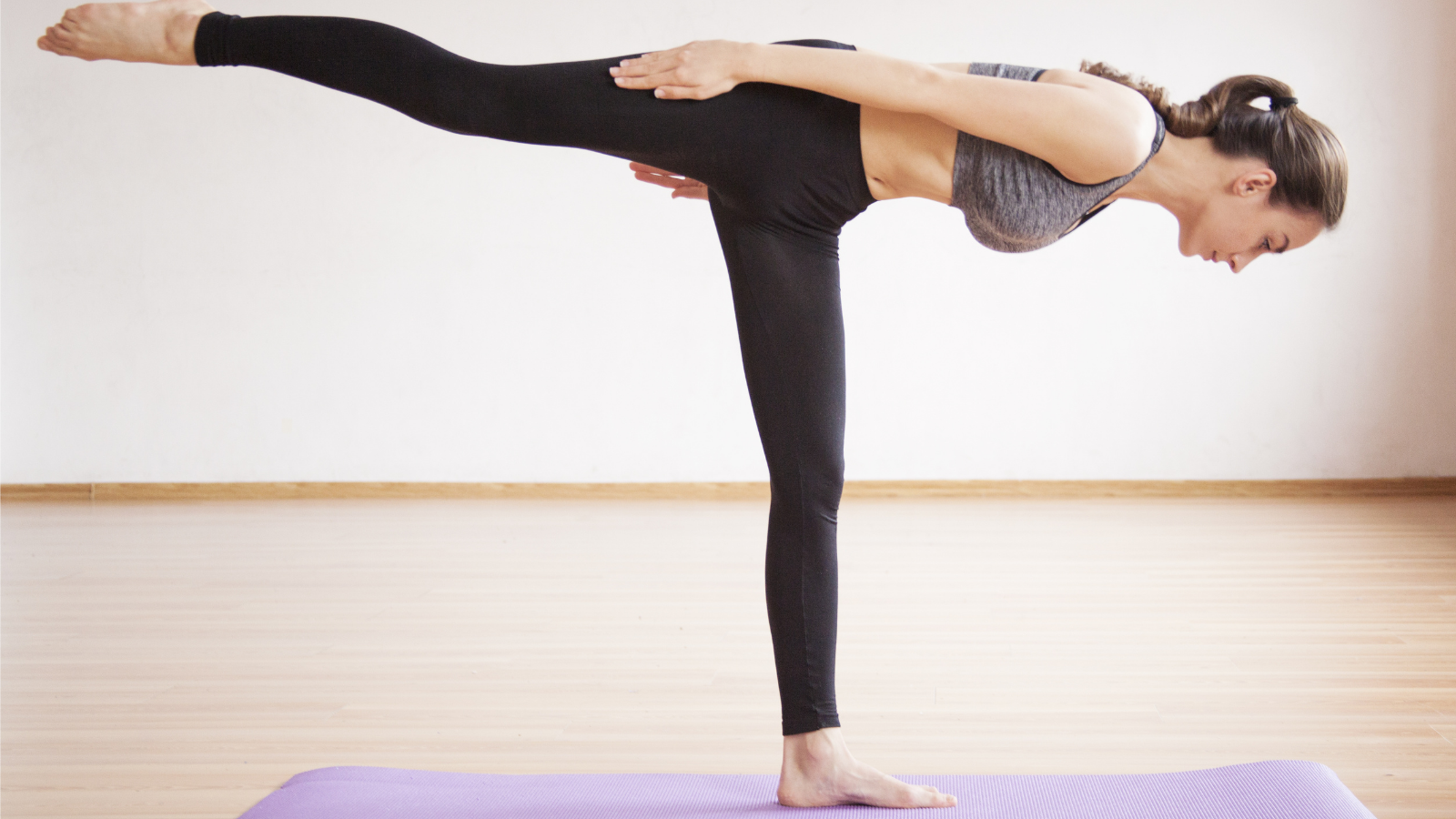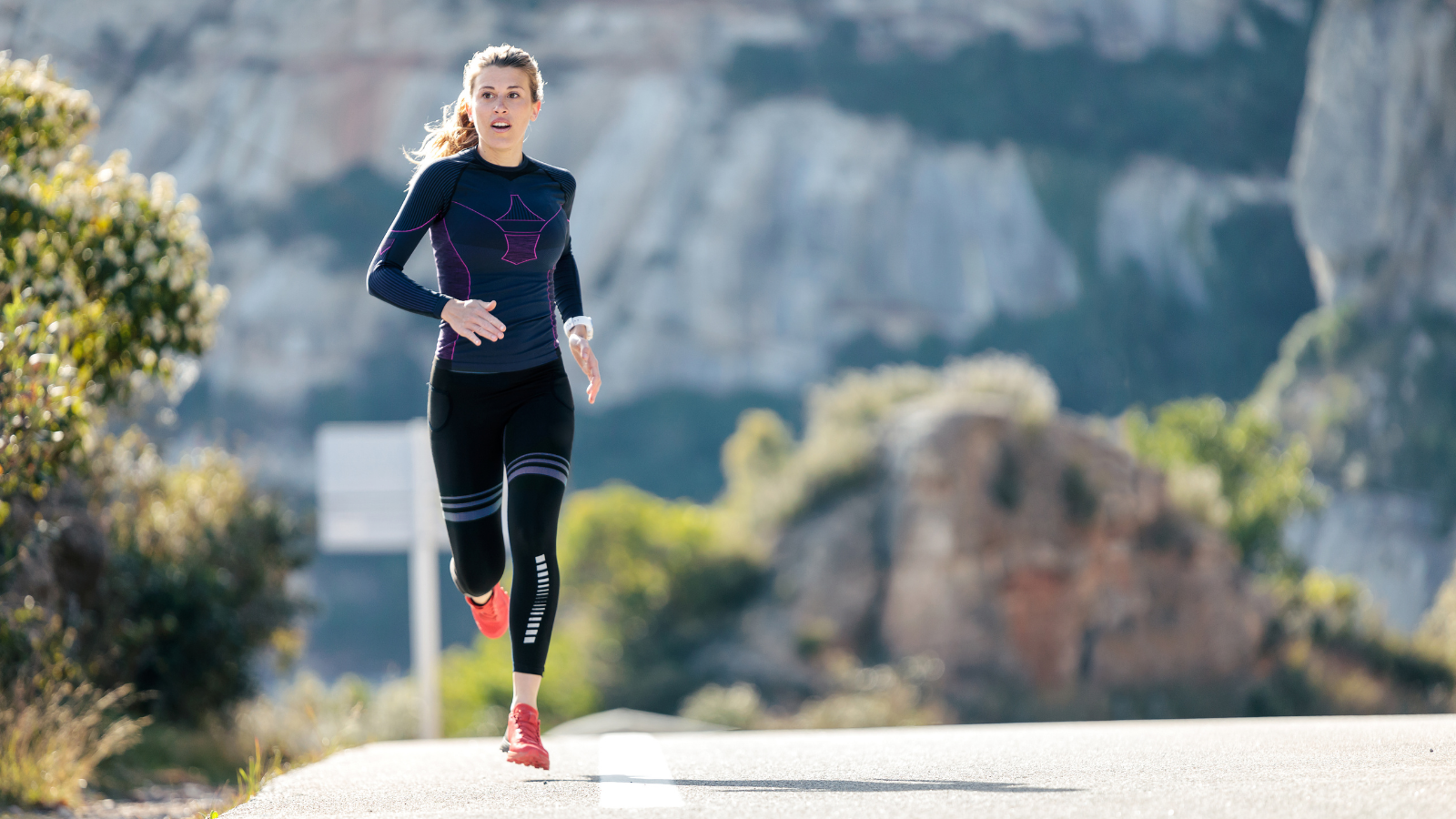View basket (0 items $0.00)

Slow Burn: A Somatic Approach to Exercise
I just read Slow Burn, an outstanding book by ultra-distance-running champion Stu Mittleman. In 1986, Stu set a world record by running 1000 miles in 11 days. He currently holds the US record for running 578 miles in 6 days—that’s 96 miles (more than three and a half marathons!) per day.
Stu’s unique approach to fitness training has gained him worldwide recognition as a fitness coach. I bought the book thinking that I would learn how to burn more fat during my workouts—I did, and I’ll describe how later in this post. But the bigger takeaway for me was Stu’s highly somatic approach to training, which is very hard to come by in the fitness world. And while the book is focused on running, you can apply Stu’s approach to any type of exercise that you enjoy.
Slow Burn is an inspiring book that all athletes and non-athletes should read. If you’re an athlete, it will make you rethink how you warm-up, train, connect with your body, and how you can fuel your body for optimal performance. If you’re not an athlete, the book will give you the confidence and knowledge you need to begin working out slowly while staying connected to your body, avoiding injuries, losing weight, and improving your strength and endurance.
Stu’s Somatic Approach to Exercise

In 1983, Stu entered his first six-day race on a whim. He had never run for more than 24 hours at a time and was by no means prepared for this race. He planned to run for as long as he could, and when he couldn’t run anymore, he’d stop and rest. After resting as much as he needed, he’d again run until he couldn’t run anymore, then stop and rest. This was Stu’s approach to life as well. He quickly found out that it wasn’t sustainable. By the second day, Stu was completely burned out and ready to quit.
Luckily, a fellow runner joined Stu as he plodded around the track and gave him some life-changing advice. He pointed out that the leading runners all had a structure to their day, in which they would run for a predetermined period of time and then rest for a predetermined period of time. They would then repeat that pattern over and over. The leading runners never let themselves get depleted. They would rest before they felt worn out. This allowed them to stay in control and be productive for the entire six-day race.
Stu immediately applied this approach to his own race, creating a repeatable schedule that worked for him. And at the end of the six days, he finished the race in second place, setting a new American record.
Taking the Path of Least Resistance
This experience led Stu to develop a somatic approach to exercise. He began to focus not on the pace he was running, but on the experience, he was having as he ran. Stu’s new priority was how effectively he could manage his state, not how fast he could run.
“Life is a marathon, not a sprint, and you must prepare accordingly. Unlike sprinters, who focus on how fast they can get to the finish line no matter the cost, endurance athletes have no finish line. There is only the present moment, in which they must remain connected to their body, in tune with their every move, in a place that feels comfortable and productive and that they are able to maintain indefinitely.” -Stu Mittleman, Slow Burn
In the book, Stu emphasizes that in order to get through a marathon—whether it be running or the marathon of life—you must develop a relationship with your body. You should treat your body as your partner; listen to its messages and don’t force it to do things it doesn’t want to do. Work with your body instead of against it. Stu advises that it is more effective to take the path of least resistance instead of ascribing to the rule of “no pain, no gain.”
Partnering with Your Body
It is through this process of paying attention to what your body is telling you that you become the expert in your body and your health. Stu writes that there is no health professional out there who is better able to make decisions about your health than you. We should learn from the experts and become as informed as possible; that knowledge, combined with a highly attuned sense of what is going on inside our body, allows us to make the best decisions about our health.
Another aspect of Stu’s training approach that’s completely in line with somatics is focusing on the process rather than the end goal. This can be a difficult thing for many people to do when they first start practicing somatic exercises. To slow down and simply focus on what you’re feeling as you move, rather than on how many repetitions you have to do or when you’ll be finished, can be extremely challenging at first. But for those of you who practice somatic exercises and have felt profound changes in your body, you know that those changes can only be achieved by focusing on the journey and allowing a process of gradual change to occur.
Process-Oriented Goals: A Somatic Approach to Exercise
Taking this approach to fitness training is even more challenging. How can you get faster or stronger if you don’t set specific goals? Stu recommends setting “process-oriented goals” like maintaining awareness of your breathing, your form, your comfort level, and your heart rate. This advice was one of the most significant takeaways from the book for me. For all my somatic training, I still approached my runs with the mentality that faster was better, and that I should always be pushing myself harder. There were judgmental thoughts in my mind as I ran: “Why aren’t you going faster? Why can’t you keep going? Why aren’t you in better shape?”
I’m happy to say that applying Stu’s approach gave me immediate results. By slowing down my pace and focusing on maintaining my breathing and heart rate, I’m able to do longer runs easily, am burning more calories, and am enjoying my runs much more. I feel zero pressure to achieve anything and am able to just relax and enjoy the experience. Stu includes case studies of his clients throughout the book, and they all have this same experience.
Relaxing Your Form
Stu also gives helpful advice on running form. He describes imagining that the earth is rotating toward you like you’re on a giant treadmill, and all you have to do is lift up your feet just enough to let the earth pass under you. To me, this feels very much like the ChiRunning form of leaning forward slightly so that you’re falling forward as you run, rather than reaching forward with your legs. Whether the imagery of the earth rotating toward you or the idea of leaning forward makes more sense to you, either one will result in you using less effort to move forward. Stu also recommends keeping your hands and face relaxed, but not slack, and focusing on diaphragmatic breathing—inhaling down into the “ball” that he describes being inside of the triangle formed by the hips and belly button.
Stu is partial to running as a form of exercise because our bodies are designed for bipedal movement; running and walking are the most natural forms of movement for us. But as I mentioned earlier, if you don’t enjoy running and walking or you’re physically unable to, don’t worry. You can apply Stu’s principles of slow, conscious exercise to any type of movement that you enjoy.

Avoid Stretching in a Somatic Approach to Exercise
Yet another aspect of Stu’s approach that’s in line with a somatic approach to exercise is that he does not advocate stretching. He says “A tight muscle doesn’t need to be stretched; it needs to be relaxed.” I agree wholeheartedly!
Note: If you read the book, you’ll learn that Stu is an advocate of muscle testing and applied kinesiology as developed by Dr. George Goodheart. This method involves the supposed connection between muscle function and internal organ function. Whether or not this connection is true is not for me to say. But I believe that pandiculation is a far more effective method of releasing muscle tension and relieving pain.
So now let’s get into the topic you’ve been waiting for: how do I burn more fat?
How We Store and Use the Energy in Our Bodies
When we eat excess carbohydrates, some of the calories get stored in our bodies as glycogen. We can store up to about 1,600 calories’ worth of glycogen in our muscles, 400 calories in the liver, and about 100 calories as glucose circulating in the bloodstream. This adds up to roughly 2,100 calories of glycogen that’s ready to be used as energy at a moment’s notice. Various sources cite anywhere from 2000 to 2,500 calories, but these estimates are all in the same ballpark.
Once our glycogen storage is full, we store excess calories from carbohydrates, fat, and protein as body fat. Most of this fat is subcutaneous (stored under the skin), and the rest is visceral fat, or belly fat (stored in the abdomen and surrounding the major organs). The amount of calories you have stored as fat depends on how much body fat you have, with one pound of body fat equaling about 3,500 calories.
Stu writes that the average person stores 134,500 calories as fat; another source estimates that the average 150-lb athlete has approximately 80,000 to 120,000 calories stored as fat. No matter the exact amount, it’s clear that fat provides us with far more potential lasting energy than glycogen.
How a Somatic Approach to Exercise Burns Fat

Our bodies use our energy stores through both aerobic and anaerobic metabolism. Aerobic metabolism can use carbohydrates, protein, or fat as its fuel source, while anaerobic metabolism can only use glucose or glycogen. So if we want to burn fat, we need to make sure we stay in the aerobic metabolic state during our workouts.
Anaerobic metabolism evolved as an emergency system, designed to give us the immediate energy we need in fight-or-flight situations. It uses our limited stores of glycogen for fast energy, and is quickly depleted, leaving us feeling worn out. In contrast, we use aerobic metabolism when we’re moving at a slow to moderate pace for long periods of time.
When we warm up slowly for a workout, we’re using aerobic metabolism and are able to burn fat. If we then continue to move at a slow to moderate pace during our workout, we can keep burning fat. But when we suddenly move fast—like when sprinting or in HIIT workouts—we shift into anaerobic metabolism, deplete our glycogen stores, get out of breath, and feel the burn of lactic acid that’s produced by anaerobic metabolism.
Think of your stored glycogen as a temporary energy reserve that will always automatically get refilled once you use it. So when you use up your stored glycogen, you’ll temporarily lose a little bit of weight—the weight of the glycogen itself and the water that is stored along with it—but that weight will come back once your body replenishes its glycogen stores. If you’re looking for lasting weight loss, focus on longer, slower fat-burning workouts, combined with consuming an appropriate amount of overall calories each day.
As Stu writes, we rely way too much on sugar as an energy source, both during workouts and in our daily lives. We automatically grab sugary snacks or energy drinks when we’re feeling sluggish, and unfortunately, consuming sugar keeps us stuck in a sugar-burning state and in a vicious cycle.
Fat-Burning vs. Sugar-Burning Muscle Fibers
We’re all born with a certain percentage of slow-twitch (type I) muscle fibers and fast-twitch (type II) muscle fibers, and this percentage varies from person to person based on genetics.
Slow-twitch muscle fibers are aerobic: they utilize fat as an energy source, require oxygen to produce energy, and produce energy relatively slowly. These are the muscle fibers that endurance athletes use to move at a slow to moderate pace for long periods of time.
Fast-twitch muscle fibers are anaerobic: they utilize sugar as an energy source and produce energy quickly. We use these muscle fibers when we sprint or do any type of explosive, high-intensity exercise.
It’s quite possible that the proportion of types of muscle fibers we’re born with may influence the type of exercise we enjoy. For example, if you’re born with a greater percentage of slow-twitch fibers, you may naturally prefer long-distance running over powerlifting because it feels easier and is, therefore, more enjoyable.
Research on Fast-Twitch vs. Slow-Twitch Muscles

Scientists are still debating whether or not slow-twitch fibers can actually change and become fast-twitch muscle fibers through physical training, and vice versa. Some research suggests that this is possible, while other research suggests that the type of muscle fibers used more often will simply increase their size and output, making them more powerful than the other type.
Various studies have found dramatic differences in the percentages of slow-twitch versus fast-twitch muscle fibers in different types of athletes. Some studies (1) have found that endurance athletes can have up to 90 to 95 percent slow-twitch fibers, while athletes like sprinters and weightlifters have 60 to 80 percent fast-twitch fibers. These huge differences suggest that muscle fibers can switch type based on physical training—but again, this topic is still debated.
And what effect does lack of exercise have on muscle fiber type? A study (2) examined the effects of immobilization on muscle fiber type and found that after three weeks, the percentage of slow-twitch, fat-burning fibers had decreased, (3) while the percentage of fast-twitch, sugar-burning fibers had increased. After the test subjects returned to normal activity, the percentages returned to where they began.
This result is fascinating because it shows that the less we move, the more likely we are to have higher percentages of fast-twitch, sugar-burning muscle fibers. So the less active we are, the more we’ll rely on sugar as an energy source—and the less capacity we’ll have to burn fat.
How Muscle Fiber Types Affect Body Weight

Along those lines, an interesting 2002 study (4) found a strong correlation between obesity and muscle fiber type. Lean women were found to have a significantly higher percentage of slow-twitch muscle fibers than obese women, who had a higher percentage of fast-twitch fibers. This makes sense, of course, because slow-twitch muscle fibers burn fat—even at rest—so people with more slow-twitch muscle fibers will tend to have less body fat.
This brings us to “marathon mouse.” (5) In 2004, researchers at the Howard Hughes Medical Institute were exploring the effects of altering the gene for the protein PPAR-delta, which helps to regulate many other genes. They were hoping to simply enhance that protein’s activity. Based on previous research, they thought that activating PPAR-delta would stimulate fat burning and decrease body fat in their mice test subjects. To their complete surprise, the single gene alteration resulted in a sizable increase in slow-twitch muscle fibers and a decrease in fast-twitch fibers in the mice.
The increase in slow-twitch fibers gave the genetically altered mice an instant physical advantage over unaltered mice in two ways. First, since slow-twitch muscle fibers are fatigue-resistant due to their large numbers of mitochondria, the genetically altered mice had incredible endurance. Even though the genetically altered mice had never run on a treadmill before, researchers were astounded that the mice could run almost twice the distance that normal mice could.
And when fed a high-fat, high-calorie diet, the genetically altered mice did not gain weight. Lead researcher Ronald Evans says: “This leads me to believe that long-distance runners, for example, possess a level of protection against weight gain even when they are not exercising. So, in a sense, they have built a kind of metabolic ‘shield’ that keeps them from gaining weight.”
So, not only will slow to moderately paced endurance workouts allow you to burn more fat during your workout, they’ll also increase the activity—and quite possibly the number—of slow-twitch muscle fibers you have, allowing you to burn more fat even while you’re at rest.
Stu’s Approach to Burning Fat

In Slow Burn, Stu describes in detail how to use a heart rate monitor to determine your three training zones: your mostly aerobic pace (MAP), most efficient pace (MEP), and speedy anaerobic pace (SAP). He recommends using a heart-rate monitor as a way to get biofeedback and train yourself to become internally aware of which zone you’re in. In his words, “structure leads to freedom.” By using a heart-rate monitor and noticing how you feel when you’re in each zone—how you’re breathing, what your heart rate feels like, how hard you feel you’re working—you can ultimately become free from the heart-rate monitor if you so desire. You’ll be able to stay in your fat-burning zone simply by noticing how you feel.
Stu spends a large portion of his book describing how to train in the three heart rate zones as well as how to fuel yourself with food and supplements. I’ll leave the details out on these topics, and encourage you to read his book if you want to fully understand his approach. Instead, I’ll finish up by offering my personal takeaways from the book.
How a Somatic Approach to Exercise Has Changed My Workout
I’ve always been a cardio-lover and have had zero interest in explosive or strength-building workouts. Before reading Slow Burn, I was doing 60- to 90- minute slow to moderately-paced cardio workouts, six days a week. But I was not fully in a fat-burning state—I was definitely burning sugar sometimes, especially during my runs, and the result was that I would tire quickly, have sugar cravings, and sometimes feel that my energy was depleted after my workout or the following day. By making some simple tweaks to my workouts, I’ve noticed significant positive changes in just three to four weeks, and I will definitely be writing to Stu to thank him!
1. I’ve slowed down. As soon as I started reading the book and understood Stu’s approach, I slowed down my running speed by five percent. Slowing down by just that small amount immediately resulted in me being able to run one to two miles longer easily, not be out of breath, and feel like I could just keep going and going. For the first time, I can understand how ultra-distance-runners do it—staying at a pace that feels easy and comfortable makes me feel like the Energizer Bunny!
2. I now prioritize my internal state. I don’t use a heart-rate monitor, so instead of pushing myself to run the same route as fast as I can like I used to do, I now focus completely on my internal state, as Stu recommends. I monitor my breathing, making sure it stays diaphragmatic, down in my belly; if it moves up to my chest I know I need to slow down. I notice how my muscles feel; if I feel the lactic acid burn, I know I’m burning sugar instead of fat, and I slow down. I pay attention to my overall sense of exertion and stress. As long as I feel relaxed, content, and like I could keep going forever, then I know I’m in a fat-burning state.

3. I don’t rely on sugar to give me energy. I used to grab a quick sugary snack before my afternoon workout, to get me going during that sluggish time of day. But now that I know intellectually that I don’t need that snack—as long as I’m eating enough overall calories and getting the right nutrition—I feel empowered to skip it. I know that I have plenty of energy stored as fat to power me through my workout. Don’t get me wrong, I get sleepy in the afternoon and there are days when I feel like I need a pick-me-up before my workout. But as Stu says in his book, “No matter how lethargic you feel or how much you don’t want to exercise, you can always make yourself feel better by moving. Movement creates energy; it doesn’t take it away.” This is so true. As soon as I get myself up and moving, I always feel more energetic. In just a few weeks of learning to skip the sugar, my sugar cravings are dramatically reduced.
4. I focus on a very slow, gradual warm-up. Stu says “the more gradually you bring your heart rate up, the richer in fat your fuel source will be.” I’ve always done slow, gentle warm-ups, and I’ve always noticed that the more slowly I increased the pace or intensity of my workout, the more energetic and strong I felt later in the workout. But I never thought about this in terms of burning fat. Now that I understand why a slow warm-up is so important from an energy perspective, I warm up even more slowly and gradually, and the result is that I feel a peak in energy and strength near the end of my workout.
5. I’ve gotten rid of the notion that faster is better. As I mentioned earlier in this post, I used to have judgmental thoughts in my head as I ran, telling myself that I should be running faster. Happily, those thoughts are gone, and I now pride myself on running slowly and learning how to maintain my internal state so that I can run farther easily, while truly enjoying myself.
These small tweaks have truly transformed my workouts in just a few weeks. If you’ve found this interesting, I encourage you to read Slow Burn so that you can learn from Stu and fully appreciate his approach. Thank you, Stu!
Recommended reading:
The Pain Relief Secret: How to Retrain Your Nervous System, Heal Your Body, and Overcome Chronic Pain by Sarah Warren, CSE
Somatics: Reawakening the Mind’s Control of Movement, Flexibility and Health by Thomas Hanna
Reprinted with permission from Somatic Movement Center.
 Sarah Warren St. Pierre is a Certified Clinical Somatic Educator and the author of the book Why We’re In Pain. She was trained and certified at Somatic Systems Institute in Northampton, MA. Sarah has helped people with chronic muscle, and joint pain, sciatica, scoliosis, and other musculoskeletal conditions become pain-free by practicing Thomas Hanna’s groundbreaking method of Clinical Somatic Education. Sarah is passionate about empowering people to relieve their pain, improve their posture and movement, and prevent recurring injuries and physical degeneration.
Sarah Warren St. Pierre is a Certified Clinical Somatic Educator and the author of the book Why We’re In Pain. She was trained and certified at Somatic Systems Institute in Northampton, MA. Sarah has helped people with chronic muscle, and joint pain, sciatica, scoliosis, and other musculoskeletal conditions become pain-free by practicing Thomas Hanna’s groundbreaking method of Clinical Somatic Education. Sarah is passionate about empowering people to relieve their pain, improve their posture and movement, and prevent recurring injuries and physical degeneration.
Resources
1. https://journals.lww.com/nsca-jscr/Fulltext/2012/06000/The_Effects_of_Endurance,_Strength,_and_Power.37.aspx
2. https://pubmed.ncbi.nlm.nih.gov/10747199/
3. https://www.ncbi.nlm.nih.gov/pmc/articles/PMC2269843/figure/fig06/
4. https://journals.physiology.org/doi/full/10.1152/ajpendo.00416.2001
5. https://www.eurekalert.org/news-releases/816612
Featured Courses









